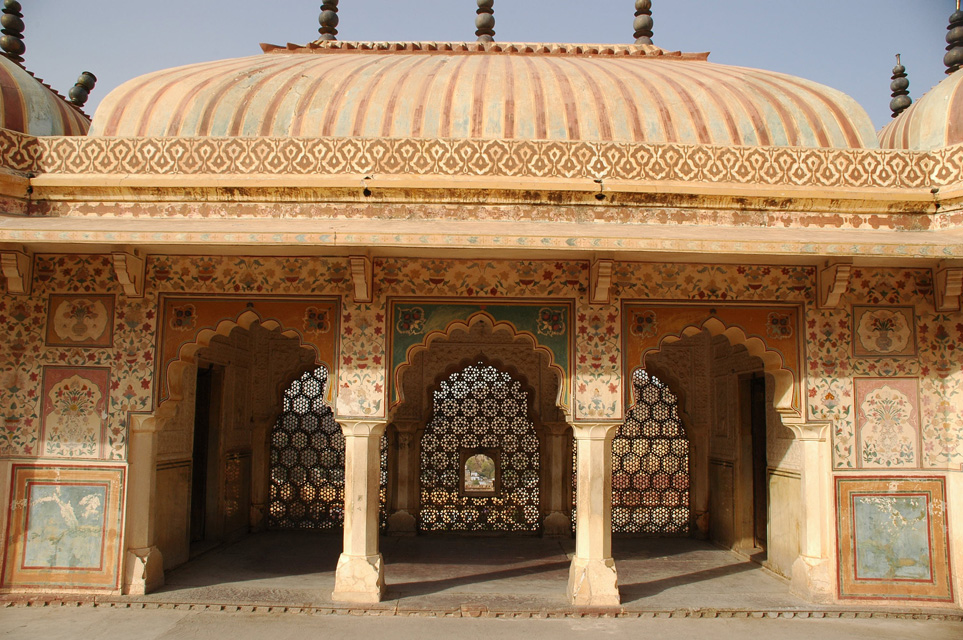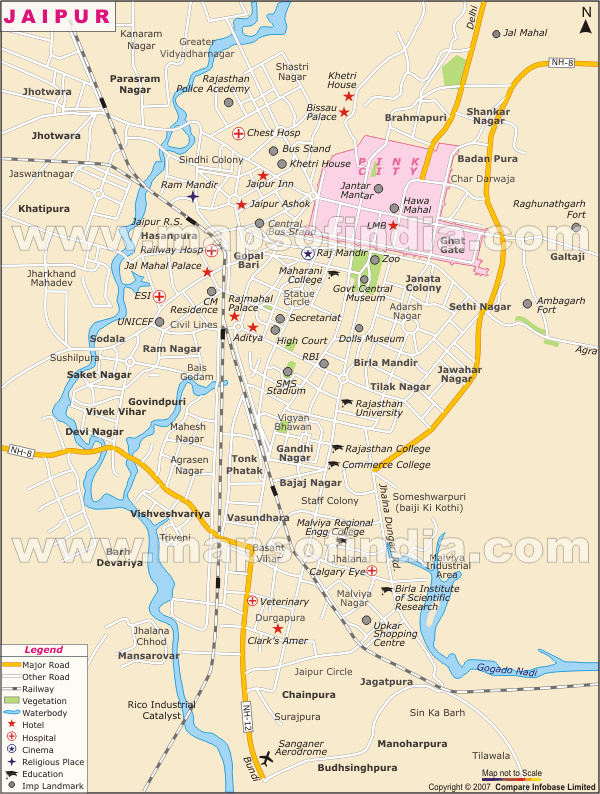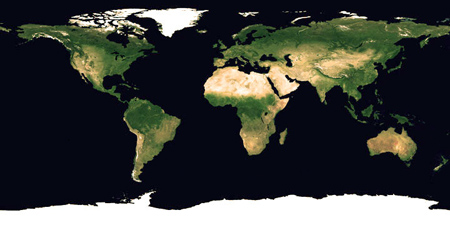


The land of golden sands, Rajasthan has its Capital at a city dyed pink in 1876, by Maharaja Man Singh II (Sawai Jai Singh) apparently to impress the Prince of Wales. This is Jaipur, fondly nicknamed the Pink City, famed for its plethora of palaces, a shopaholics apple-pie for its beatific indigenous products and its capacity to hypnotize the visitors into believing - here is another world.
Tale of the City
And if you can afford some time-management, the festivals are an excellent time to come. The city takes on a different hue altogether, brighter even then its signature pink, during the Elephant Festival (March), Gangur (March-April) and Teej (July-August).
Amber Fort : Amber Fort the ancient capital of the State until 1728. Visit the Jag Mandir or the Hall of victory glittering with mirrors, Jai Mahal and Temple of Kali. Ascend on Elephant back, the hill, on which the fort is situated.

Jantar Mantar: The five astronomic observatories are Sawai Jai Singh products. Before constructing this and the four others, he sent his emissaries to all corners to the world, who returned with many manuals of cutting-edge technology including a copy of La Hire's Tables. No wonder the Jantar Mantar, as it came to be called, was to some wonder of its kind and in fact 20 seconds more accurate than that given by La Hire. Out of the five of his observatories in India, the one here at Jaipur is the only one running fine even now. Situated within the City Palace Complex, go there and explore it at leisure.
Hawa Mahal: The Palace of the Wind, used to be the royal zenana or the private chambers of the ladies from where they would view the activities of the city. Today tourists visit, mostly during October to February, to bathe themselves in the wallowing wind and sweep the entire Pink City at one glance from its pristine heights.
Jaigarh Fort: Situated north of Jaipur, Jaigarh Fort or the Victory Fort (open daily 9am-4:30pm) houses the world's largest cannon (Jaivan). Structurally it reminisces the Amber fort, just that the three water holes, a regal museum and of course some eclectic views it commands, make is singularly special.
Central Museum: The plush city garden Ram Niwas Bagh, houses in its heart the Albert Hall or the Central Museum with arched pillars, courtyards adorned with murals and a world of miniature paintings, ivory carvings, costumed mannequins, shields depicting scenes from the Hindu epics - all standing as insignia's of an unparalleled regal past.
Temples: Delhi's Birla Mandir cousin is the Birla Mandir or the Laxmi Narayan Temple at Jaipur, situated south of the city and built in pure white-marble with three imposing domes. The Govind Devji Temple, Moti Doongari, Akshardham Temple (at Vaishali Nagar), Jain Mandir (Shivdas Pura) are the other noted temples you should flock to.
Festivals in Jaipur: The Elephant Festival is held every year in March/April to celebrate Holi and is held the day after Holi. Elephants are beautifully decorated and paraded along with camels, horses and folk dancers, musicians, lancers on horseback, cannons, fleet of palanquins, chariots. The main attractions are Beauty Peagant for Elephants, Elephant races, Elephant polo matches and the most interesting - tug of war between elephants and men. And the venue is Chaugan Stadium.
The Gangaur Festival (celebrated all over Rajasthan) is another significant event of Jaipur event. . This is the best time to land in Jaipur and partake in the fun-fare and watch the famous procession of decorated elephants, camels, horses and palanquins, taken from City Palace Gate to Talkatora, en route Chaugan.
For jewelery (Kundan jewellery) and gems, flock to Johari Bazaar in the Old City, the gem center of Jaipur. The cutting, polishing, and selling of gems and the making of silver jewelry take place in the predominantly Muslim area of Pahar Ganj in the Surajpol Bazaar. For those who just can't do without bargaining, these jewelery joints might be a disappointment, but your money will be worth the quality of the wares here.

Jaipuri tie-and-die fabrics, finest one is called bandhani (meaning 'to tie'), with crinkly circles (you will have to see them to really understand the interesting handiwork), are best at Bapu Bazaar (near Johari Bazaar; closed Sun). For block-print fabrics head to the Jaipur Airport area at Sanganer, a village 15 km south of Jaipur, known as the birthplace of block work and home to the largest handmade-paper industry in India. For fabrics check out Shilpi Handicrafts, Anokhi and Sakshi, and Salim's for handmade paper. In fact brass and lacquer work, enamel work, gems and jewelery, granite tiles, handloom, marble statues, printed cloth and textiles, ready made garments, woolen and silk carpets form Jaipur's main items of export.

After an exhausting camel ride safari, drop in at the Choki Dhani (22 km out of the city), a must-go where your meals will be tangoed with doses of folk performances in the backdrop.
Across the road from Niros is Lassiwalla, where the chilling yogurt drink served in large terracotta mug (can be kept as a memento).
Snippets
Mehendi: This temporary form of skin decoration (tattoo-like in shades of orange) is very popular and women apply it on their hands and feet during festivals. The designs are another intricate handiwork and female tourists must try a hand at it.


Albert Hall Museum, Jaipur

Jaighar Fort garden
About 8 km east of Jaipur, on the Jaipur-Agra highway is the terraced Sisodia Rani Ka Bagh (the Garden of Sisodia Queen) created by the Queen of Jai Singh II as an escape from the court intrigues. Behind the gardens, is perched the Hanuman (monkey God) temple, where the spectacle of hundreds of monkeys swarming to be fed by the priests is one that will go your camera clicking on and on. A little farther, along the Agra road is pretty Galta, a gorge filled with sacred kunds (natural pools or reservoirs), all fed by pure spring water that falls from a rock resembling a carved cow's mouth, and surrounded by temples.
Hop Next to: Continue your rendezvous with the land of regal heritage, Rajasthan, to the beautiful city of lakes of Udaipur, the stunning fort of Jodhpur and onto the enchanted desertland of Jaisalmer or dare the sand dunes at Bikaner.
Access
RAIL : The Jaipur Railway Station, located west of the Old City, has trains plying regularly to Delhi (4 ½ hr), Agra (5 hr), Mumbai, Chennai, Bikaner, Jodhpur, Udaipur, Ahmedabad and so on. The Shatabdi Express, the Pink City Express and the regal luxury train Palace on Wheels, are the trains from Delhi. For further details you can visit the Indian Railway website: www.indianrail.gov.in.
ROAD :Jaipur, being part of the Golden Travel Circuit of India (that includes Delhi-Agra-Jaipur) has excellent roads and a well-networked inter-state bus terminus called the Sindhi Camp bus stand. Regular AC Volvo buses for Delhi (about 12 departures a day) will drop you off at Bikaner House, near India Gate. Drive the NH 8 to reach Jaipur in only 4 hours from Delhi.
Distances from nearby cities :
| Delhi: | 260 km |
| Agra: | 232 km |
| Ajmer: | 131 km |
| Alwar: | 142 km |
| Sariska: | 111 km |
| Sawai Madhopur: | 114 km |
| Jodhpur: | 342 km |
| Bikaner: | 321 km |
| Jaisalmer: | 665 km |
| Udaipur: | 405 km |
Stay At
Five Star Deluxe Hotels and budget hotels also are flaked around in plenty if you want to wake up in your regular hotel rooms.
Book a Hotel in Jaipur 
| Heritage Hotels in Jaipur : | |
| Ramgarh Lodge | Royal Castle Kanota |
| Narain Niwas Palace | Raj Mahal Palace |
| Samode Haveli | Hotel Alsisar Haveli |
| Hotel Samode Palace | Hotel Bissau Palace |
| Five Star Deluxe Hotels in Jaipur : | |
| Rajvilas - An Oberoi Hotel | The Rambagh Palace Hotel |
| Jai Mahal Palace | Rajputana Palace Sheraton |
| Five Star Hotels in Jaipur : | |
| Man Singh Towers | Hotel Man Singh |
| Chokhi Dhani - The Ethnic Village Resort | Hotel Clarks Amer |
| Hotel Jaipur Palace | |
| Four Star Hotels in Jaipur : | |
| The Trident | Hotel Jaipur Ashok |
| Hotel Maya Inter Continental | |

Categories:
India Tourist Spots,
Jaipur


0 comments:
Post a Comment